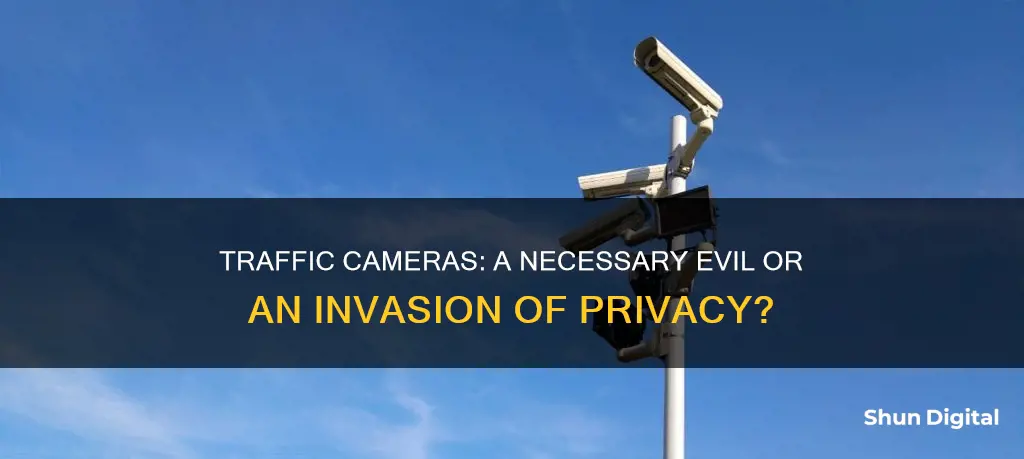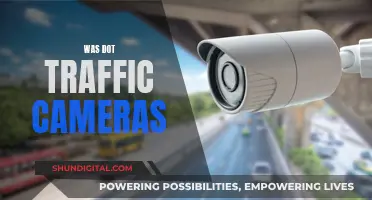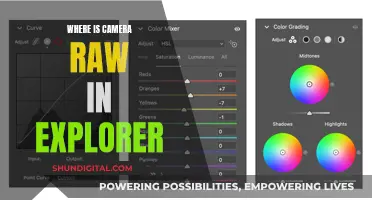
Traffic cameras are a common sight on roads and highways, but their presence has sparked a debate about whether they pose a threat to privacy. These cameras are typically installed on highways, major roads, and intersections to monitor and manage traffic flow. While some argue that they are essential for ensuring safety and enforcing traffic rules, others express concerns about potential privacy invasions and the misuse of data. The question of consent also arises, as individuals may feel that constant monitoring without their explicit permission is an intrusion.
Traffic cameras, often equipped with artificial intelligence, can capture images and videos of vehicles and drivers, raising concerns about data collection and surveillance. The data collected by these cameras can be stored and analysed, leading to possible misuse by authorities or hackers. Additionally, the knowledge that one is under constant surveillance can have a chilling effect on freedom of expression and behaviour.
While traffic cameras have been credited with reducing accidents and saving lives, the debate surrounding their impact on privacy and civil liberties remains complex and multifaceted.
| Characteristics | Values |
|---|---|
| Purpose | Monitoring and assisting in traffic flow |
| Installation Location | Highways, major roads, tunnels, surface roads, remote areas |
| Connection | Optical fibres, buried alongside or under the road |
| Power Source | Mains power, solar panels, alternative power sources |
| Data Collection | Licence plate recognition, facial recognition |
| Privacy Concerns | Constant monitoring, location tracking, data security |
| Safety Benefits | Deterring crime, monitoring traffic conditions, reducing congestion |
What You'll Learn

Privacy invasion
Traffic cameras, especially red-light cameras, have been a topic of debate regarding their potential invasion of privacy. These cameras are typically installed on highways and major roads to monitor and manage traffic flow. While some argue that they do not infringe on privacy, others, including the American Civil Liberties Union (ACLU), have raised valid concerns about the potential for privacy abuses.
One argument against the privacy invasion claims is that driving is a regulated activity, and individuals are required by law to register their vehicles and obtain a driving license, agreeing to abide by traffic rules. Red-light cameras are part of the traffic surveillance system, capturing only those who break the rules. Additionally, drivers are usually aware of the presence of these cameras, and their purpose is not to monitor in-vehicle activities. Similar to cameras in other public places, red-light cameras do not capture activities within the vehicle itself, focusing only on the driver and license plate.
However, the ACLU and others have expressed concerns about "mission creep," where data collected by these cameras could be used for purposes beyond tracking reckless drivers. There is a precedent for this, as cameras installed at the Texas-Oklahoma border have captured the license plate numbers of law-abiding individuals, subjecting them to inquiries about their border crossing. This example illustrates how easily data collected by traffic cameras can be misused or abused.
The use of surveillance cameras in private and public spaces has become increasingly common, and this proliferation of technology has serious implications for individual freedom and privacy. While cameras can deter and help solve crimes, their constant surveillance can impact free speech and activity. The data collected by these cameras can be a valuable tool for law enforcement, but it also raises concerns about potential abuse and societal discrimination. For instance, when algorithms are fed biased data, they reinforce and intensify biases in law enforcement.
To address these privacy concerns, appropriate laws and guidelines are necessary to ensure the rightful use of private data obtained through surveillance cameras. Public authorities should implement policies for handling such data and establish penalties for any breaches. It is essential to strike a balance between public safety and the protection of citizens' privacy rights.
Extend Trail Camera Battery Life with These Tips
You may want to see also

Data security
Traffic cameras are a valuable tool for monitoring and managing traffic flow, but they also raise concerns about data security and privacy invasion. The cameras collect and transmit data in real time, which can be vulnerable to hacking and unauthorised access.
The data collected by traffic cameras includes license plate information, vehicle movement, and in some cases, the driver's image. This data is transmitted to monitoring centres and, in some jurisdictions, made available to the public through live traffic reports. While this data collection has a legitimate purpose—improving traffic management and road safety—it also creates a potential risk for abuse and misuse.
To address these data security concerns, several measures can be implemented. Firstly, encryption and secure data storage practices are essential to protect data from unauthorised access. Strong encryption protocols should be applied to all data transmissions and storage, with regular updates to encryption keys and algorithms to stay ahead of emerging hacking techniques.
Secondly, strict access control policies should be enforced. Only authorised personnel should have access to the data, and their activities should be monitored to prevent misuse. Role-based access control can be implemented, restricting access to specific data based on an individual's role and responsibilities. Additionally, two-factor authentication and other robust authentication methods should be mandatory for accessing the data.
Thirdly, data retention policies should be established and adhered to. Data should be retained only for as long as necessary to fulfil the stated purpose, after which it should be securely deleted. This reduces the risk of data falling into the wrong hands and minimises the potential for abuse.
Finally, independent oversight and regular audits of the traffic camera system are crucial. An independent body should be given the authority to monitor the use of the system, review data access logs, and investigate any potential privacy violations or data breaches. Regular audits will help identify vulnerabilities and ensure that data security measures are effectively implemented.
By implementing these measures, the benefits of traffic cameras in improving road safety and traffic management can be realised while also safeguarding the data security and privacy rights of individuals.
Charging Your Spy Gear Camera: How Long is Enough?
You may want to see also

Surveillance normalisation
Traffic cameras are an increasingly common feature of roads and highways, and their use has sparked a debate about whether they pose a threat to privacy and represent a form of surveillance normalisation.
Traffic cameras, including red light cameras and speed cameras, are typically installed on highways, major roads, and in urban areas to monitor and manage traffic flow. They are also used to detect and enforce motoring offences, such as speeding, running red lights, and unauthorised use of bus lanes. While these cameras are primarily used for traffic management and safety, they have also sparked concerns about privacy and surveillance normalisation.
The normalisation of traffic cameras as a form of surveillance is evident in the increasing acceptance and reliance on these technologies by governments and law enforcement agencies. For example, a study in the British Medical Journal reported that speed cameras were effective at reducing accidents and injuries and recommended their wider deployment. Additionally, some drivers have come to expect the presence of traffic cameras and may even use them to their advantage, such as by checking traffic conditions before choosing a route.
However, the normalisation of traffic cameras as a form of surveillance also raises concerns about privacy and government overreach. Traffic cameras, particularly those with automated number-plate recognition technology, can be used for mass surveillance of vehicle movements and, by extension, the movements of vehicle owners. This data can be vulnerable to hacking or misuse by authorities or organisations. While some may argue that individuals have no expectation of privacy in public spaces, others argue that constant monitoring without consent is an invasion of privacy.
To address these concerns, it is essential to have robust legal frameworks and policies in place to regulate the use and handling of data collected by traffic cameras. This includes ensuring that individuals' privacy rights are respected and that data is used solely for its intended purpose, such as traffic management and safety. Additionally, there should be accountability measures in place to address any privacy violations or abuses that may occur.
Surveillance Cameras: What You Need to Know
You may want to see also

Location tracking
Traffic cameras are a threat to location tracking, as they can be used to monitor and record an individual's movements. This is especially true with the latest automatic number-plate recognition systems, which can be used to detect the average speeds of vehicles and track their movements. This information can then be used to determine the location and movement patterns of the vehicle's owner. While this technology can be useful for law enforcement and traffic safety, it raises concerns about privacy and the potential for government surveillance.
Modern surveillance systems often employ facial recognition and license plate recognition technologies, enabling them to track individuals' movements and activities. This allows for the creation of detailed profiles of a person's daily routines and whereabouts. For instance, a person's location data can reveal where they live, work, and spend their free time. This information can be accessed and misused by authorities, organizations, or hackers, posing a threat to personal privacy and security.
The use of traffic cameras for location tracking is not limited to law enforcement. Transportation departments often link their camera networks to the internet, allowing travellers to view traffic conditions in real time. While this can be helpful for route planning, it also means that anyone can access this information, including potential stalkers or thieves. Additionally, television stations may air live traffic camera imagery during news broadcasts, further increasing the accessibility of this location data.
The integration of artificial intelligence with traffic cameras, such as ANPR cameras, enhances their location tracking capabilities. These cameras can read license plate numbers and track the whereabouts of drivers, which can be uncomfortable for many individuals. Mobile ANPR cameras, mounted on police cruisers, can automatically scan and cross-reference license plates with government databases. While this can be useful for officer safety, it also raises concerns about government overreach and potential misuse of personal data.
In conclusion, traffic cameras pose a threat to location tracking by enabling constant monitoring and collection of location data. This data can be accessed and misused by various entities, infringing on individuals' privacy and sense of security. As technology advances, it is crucial to implement appropriate regulations and safeguards to protect personal information and ensure the responsible use of traffic cameras for location tracking.
Understanding Camera Raw Cache in Lightroom
You may want to see also

False positives
Traffic cameras are a valuable part of intelligent transportation systems. They are often used in tunnels and on surface roads, and are particularly useful in monitoring traffic flow and determining traffic light timing. However, they have also sparked concerns about privacy invasion and the potential for false positives.
Automated traffic enforcement cameras, such as red-light cameras and speed cameras, rely on artificial intelligence and image recognition technology to detect and capture vehicles that are breaking the law. While these systems have improved over time, they are not perfect and can sometimes make mistakes. For example, a red-light camera may fail to accurately detect the colour of a traffic light or the position of a vehicle when the image is captured. Similarly, speed cameras may not always accurately capture the speed of a vehicle, especially in areas with varying speed limits or complex traffic patterns.
To minimise false positives, traffic camera systems should incorporate advanced technologies, such as deep learning AI, to enhance accuracy and reduce errors. Regular maintenance and calibration of the cameras are also essential to ensure they are functioning correctly and capturing accurate data. Furthermore, implementing a robust review process before issuing penalties can help identify and rectify false positives, protecting innocent individuals from unfair consequences.
Fixing Upside-Down Camera Issues on Your Computer
You may want to see also
Frequently asked questions
Traffic cameras are usually installed on highways, major roads, and intersections to monitor and manage traffic flow. They may be connected to optical fibers and powered by electricity, solar panels, or alternative sources. Some cameras capture still photos, while others record lower-resolution videos. They may also have license plate recognition technology and be linked to automated ticketing systems.
Traffic cameras are generally placed in public spaces, and their presence is often known, so they do not infringe on privacy laws. However, some people argue that the extensive use of traffic cameras and the collection of vehicle and driver data could potentially lead to privacy breaches and government overreach.
Traffic cameras improve road safety by deterring traffic violations, capturing evidence of accidents, and helping identify individuals involved in incidents. They also assist in traffic management by providing real-time data on traffic flow, which can be used to reduce congestion.
Beyond privacy concerns, some critics argue that traffic cameras and automated ticketing systems are more about generating revenue than improving road safety. There are also worries about the potential for abuse and unfair targeting of specific individuals or groups. Additionally, the effectiveness of traffic cameras may vary across different jurisdictions, making them less effective in certain areas.







